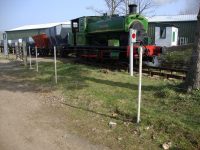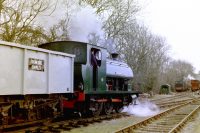Rocks by Rail in Rutland has added two original iron ore wagons to its collection following a transfer from the National Railway Museum.
The two wagons, namely, a British Railways built 27 ton iron ore tippler and a 22 ton iron ore hopper wagon, had been on loan from the National Collection for a number of years to Rocks by Rail – the Living Ironstone Museum situated near Cottesmore in Rutland. The Tippler wagon had seen occasional use in the museum’s demonstration ironstone quarry trains on open days, whilst restoration work was undertaken by the museum’s volunteers on the hopper wagon.
On loan ironstone quarry locomotive SALMON pulls a rake of iron ore hopper wagons heading for the mock quarry area at the Museum. Hopper wagon B 436275 is the first wagon in the consist.
The Museum applied to the National Railway Museum, part of the Science Museum Group, to retain the two wagons within its own collection – which represents the only comprehensive collection of standard gauge ironstone quarry rolling stock in the UK. Ore wagons of these types were commonly found working at ironstone quarries in Rutland and the East Midlands from the early 1950s until the quarries closed at the end of the 1960s.
In early May, the Museum was notified that the application had been successful and that the two wagons are now officially part of the Museum’s collection.
Iron Ore Tippler wagon B383560 is shunted by quarry locomotive CRANFORD No.2 at the Museum in 2010
Mr David Atkinson, Chair of Rocks by Rail Museum Trustees commented: “We are very grateful to the Science Museum Group for agreeing that these two iron ore wagon exhibits can be transferred to this accredited Museum. This will safeguard their future conservation and the wagons will continue to see occasional use on public open days where they will be included in demonstration quarry trains operating within the mock ironstone quarry at the museum, thus helping to re-create local ironstone quarry heritage for the benefit of museum visitors.”
Ed Bartholomew, Lead Curator at the National Railway Museum, said: “As part of the managing the national collection, we occasionally transfer items if we believe there may be more suitable organisations for their display, with a view to making the collection more accessible.
“The two wagons have been well looked after at Rocks by Rail for many years and as permanent parts of the collection they will help tell the story of the railway’s important role in the transportation of iron ore.”



